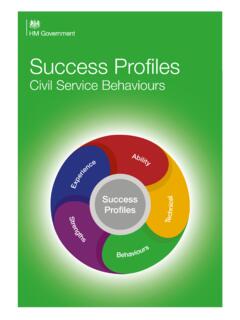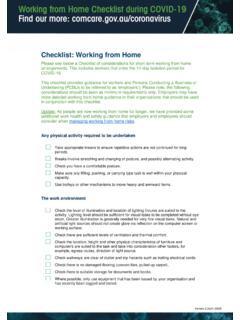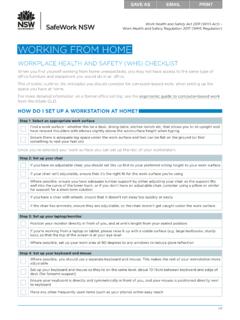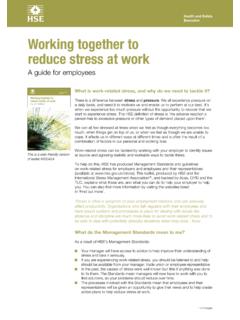Transcription of Maintaining portable electrical equipment in low-risk ...
1 Page 1 of 6 Health and Safety ExecutiveMaintaining portable electric equipment in low-risk environmentsThis is a web-friendly version of leaflet INDG236(rev3), published 09/13 IntroductionThis leaflet explains the simple and sensible precautions that need to be taken to prevent danger from portable or movable electrical equipment in low-risk environments, such as offices, shops, some parts of hotels and residential care also provides examples of this sort of equipment to help you decide what you need to do to maintain portable appliances in your workplace. What does the law say?You must maintain electrical equipment if it can cause danger, but the law* does not say how you must do this or how often.
2 You should decide the level of maintenance needed according to the risk of an item becoming faulty, and how the equipment is constructed. You should consider: the increased risk if the equipment isn t used correctly, isn t suitable for the job, or is used in a harsh environment ; and if the item is not double insulated, for example some kettles are earthed but some pieces of hand-held equipment , such as hairdryers, are usually double insulated. See page 4 for more information on earthed equipment and double insulated equipment . This includes any electrical equipment your employees use at work, whether it is their own or supplied by you. You have a joint responsibility to maintain any equipment used by your employees that is either leased (eg a photocopier) or provided by a contractor (but not equipment both provided and used by a contractor).
3 You will need to check periodically if any work needs doing. How you do this depends on the type of equipment . Not every electrical item needs a portable appliance test (PAT)In some cases, a simple user check and visual inspection is enough, eg checking for loose cables or signs of fire damage and, if possible, checking inside the plug for internal damage, bare wires and the correct fuse. Other equipment , eg a floor cleaner or kettle, may need a portable appliance test, but not necessarily every year. * Electricity at Work Regulations 1989 Health and Safety ExecutiveMaintaining portable electric equipment in low-risk environments Page 2 of 6 How do I ensure the safety of electrical equipment ?
4 Encourage employees to look at the supply cable to the electrical equipment before they use it (user check). Encourage employees to look at electrical equipment before they use it (user check). Make sure that all portable equipment is visually inspected at initial intervals which could be between six months and four years, depending on the type of equipment . See the last bullet point on this list and Table 1 at the end of this leaflet for more information. Arrange for equipment that is not double insulated to have a portable appliance test (including leads) at initial intervals which could be between one and five years, depending on the type of equipment .
5 Ensure that damaged or faulty equipment is recognised, removed from use without delay and either: repaired by someone competent (ie with suitable training, skills and knowledge for the task to prevent injury to themselves or others); or disposed of to prevent its further use consult your local authority about arrangements for disposing of electrical equipment . Review your maintenance system to determine whether you could decrease or increase your inspection and/or testing intervals. You may find it useful to keep records of all inspections and tests, and to label equipment with the result and date of the test, but there is no legal requirement to do either of these things.
6 Table 1 at the end of this leaflet gives an initial indication of where a visual inspection should be sufficient and where testing may be needed in order to comply with the law. It also suggests initial intervals for the different types of checks, visual inspection and portable appliance testsUser checks These should be carried out before most electrical equipment is used, with the equipment disconnected. Employees should look for: damage to the lead including fraying, cuts or heavy scuffing, eg from floor box covers; damage to the plug, eg to the cover or bent pins; tape applied to the lead to join leads together; coloured wires visible where the lead joins the plug (the cable is not being gripped where it enters the plug); damage to the outer cover of the equipment itself, including loose parts or screws; signs of overheating, such as burn marks or staining on the plug, lead or piece of equipment ; equipment that has been used or stored in unsuitable conditions, such as wet or dusty environments or where water spills are possible.
7 And cables trapped under furniture or in floor inspectionsTo carry out a visual inspection you don t need to be an electrician, but you do need to know what to look for and you must also have sufficient knowledge to avoid danger to yourself and others. Simple training can equip you (or a member of staff) with some basic electrical knowledge to enable you to carry out a visual inspection competently. Health and Safety ExecutiveMaintaining portable electric equipment in low-risk environments Page 3 of 6As part of the visual inspection, you should consider whether: the electrical equipment is being used in accordance with the manufacturer s instructions; the equipment is suitable for the job; there has been any change of circumstances; and the user has reported any visual inspection should include the checks carried out by the user and, where possible, will include removing the plug cover and checking internally that: there are no signs of internal damage, overheating or water damage to the plug.
8 The correct fuse is in use and it s a proper fuse, not a piece of wire, nail etc; the wires including the earth, where fitted, are attached to the correct terminal (see Figure 1); the terminal screws are tight; the cord grip is holding the outer part (sheath) of the cable tightly; and no bare wire is visible other than at the terminals. For equipment /cables fitted with moulded plugs only the fuse can be checked. portable appliance test (PAT)A portable appliance test does not need to be carried out by an electrician, but greater knowledge and experience is needed than for inspection alone, and the person performing the test must have the right equipment for the task.
9 They should know how to use the test equipment and how to interpret the results. Figure 1 A correctly wired plugHealth and Safety ExecutiveMaintaining portable electric equipment in low-risk environments Page 4 of 6It is important to continue to carry out user checks on electrical equipment that has been tested. This is because portable appliance testing can only give an indication of the safety of an appliance at the time of the test and does not imply that the item will be safe for a further period of time. The person carrying out the test should not assess when the next test will be due as this decision should be made by you on a risk assessment basis.
10 portable and movable equipmentA portable or movable electric appliance is any item that can be moved, either connected or disconnected from an electrical supply. portable or movable items generally have a lead (cable) and a plug. portable and movable equipment includes the following: electrical equipment that can be easily moved around, such as kettles, vacuum cleaners, floor polishers, portable heaters, fans, desk lamps, some TVs, radios, some small electric cookers, PC projectors, small appliances such as irons, hair dryers and kitchen equipment including food mixers, toasters etc; larger items that could be moved (but only rarely), eg water chillers, fridges, microwaves, photocopiers, vending machines, washing machines, electric cookers, fax machines, desktop computers, electric beds etc are considered to be movable items.


















